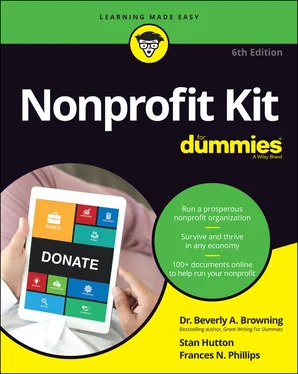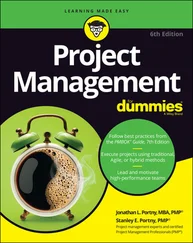The nonprofit sector is larger than many people realize. Here are some figures from the National Center for Charitable Statistics, based on IRS data, and the Independent Sector, regarding 501(c)(3) public charities in the United States:
Nearly 1.6 million organizations were registered as public charities with the IRS in 2020.
Assets held by these groups in 2020 totaled more than $3.79 trillion.
Nearly 30 percent of public charities that reported to the IRS in 2019 had annual expenses of less than $100,000.
Embracing and Sharing Your Inspiration
The nonprofit sector is exciting. It encourages individuals with ideas about solving social problems or enhancing arts, culture, the environment, or education to act on those ideas. It creates a viable place within our society and economy for worthy activities that have little chance of commercial success. Nonprofit organizations combine the best of the business world with the best of government social-service programs, bringing together the creativity, zeal, and problem-solving from the business side with the call to public service from the government side.
Speaking from experience, volunteerism is inspiring. Everyone has heard stories of tightly knit communities where neighbors gather to rebuild a home that was lost to a fire or a hurricane. That spirit of pitching in to help is the best part of living in a community in which people share values and ideas.
Communities have become more diverse and are populated with neighbors who come from a wide variety of places and cultures. The nonprofit sector provides institutions and opportunities where everyone can come together to work toward the common good. Volunteerism gives everyone the chance to pitch in to rebuild “the house and make it a home again.”
Applying the term voluntary sector to nonprofit organizations came about for a good reason. The US Census Bureau reported that 77.3 million people volunteered at least once in 2020.
When you’re working in a nonprofit, you’ll likely be supervising volunteers — and they’ll likely supervise you. What we mean is that (with few exceptions) nonprofit boards of directors serve as unpaid volunteers. And if you’re the executive director, your supervisors are the trustees or board members of the organization. At the same time, you likely depend on volunteers to carry out some or all of the activities of the organization. You may serve as a volunteer yourself.
 The word supervision sounds harsh, and we don’t mean to suggest that nonprofits are or should be run with an iron hand. The board of directors does have ultimate responsibility, however, for the finances and actions of a nonprofit organization, and, therefore, people serving in that capacity have a real duty to make sure that the organization has sufficient resources to carry out its activities and that it’s doing what it’s supposed to be doing.
The word supervision sounds harsh, and we don’t mean to suggest that nonprofits are or should be run with an iron hand. The board of directors does have ultimate responsibility, however, for the finances and actions of a nonprofit organization, and, therefore, people serving in that capacity have a real duty to make sure that the organization has sufficient resources to carry out its activities and that it’s doing what it’s supposed to be doing.
We prefer to think of nonprofits as organized group activities. You need to depend on others to reach your goals, and they need to depend on you. We talk about boards of directors in Chapter 7and working with volunteers in Chapter 10. If your nonprofit employs paid staff or hopes to someday, Chapter 11provides some guidance in hiring and managing employees.
CURIOSITY REWARDED THIS CAT
Here’s a story about a nonprofit dreamer, perhaps much like yourself, who (spoiler alert!) started her own nonprofit and made it sustainable with hard work, self-investment, and resourcefulness.
I (Bev) had worked in the corporate sector of small- to midsize businesses for decades. My supervisors and their demeanor set the tone for each workday. There were good days and not-so-good days in my multiple workplaces. One day, I was approached by a nonprofit executive director who invited me to attend a board meeting. Somewhat perplexed at the invitation to attend a meeting for an organization that I was unfamiliar with seemed an overstretch given my business employment experiences. Yet, out of a wee bit of curiosity, I decided to attend.
I was greeted by the board of directors and the executive director (the source of my invitation to attend the meeting). Everyone seemed genuinely interested in getting to know me. I was asked if I had ever done any volunteer work or served on a board. I shared my longtime volunteer experiences with other agencies and my time as a foster parent. There were lots of smiles around the boardroom table. A board member asked me if I would stay for the entire meeting and listen to their updates on policies, programs, and processes for the Voluntary Action Center of Genesee and Shiawassee counties. At the end of the board meeting, I was invited to join the board of this well-established nonprofit organization. Guess what? I did! Thus began my learning process about nonprofit organizations, how they operate, their mission and vision statements, and clarification on ownership. It was that first experience, which lasted for two years, that made me start to dream about starting my own nonprofit organization. Yes, you read this right! I went on to form two successful nonprofit organizations.
Finding the Resources to Do the Job
One distinctive feature of the nonprofit sector is its dependency on contributions. We devote many pages of this book — most of Part 3— to advice about getting contributions from fundraising.
Gifts from individuals of money, goods, services, time, and property make up the largest portion of that voluntary support. This portion, which is also the oldest of the voluntary traditions in the United States, dates back to colonial times. Since the late 19th century, private philanthropic foundations have emerged as another source of support, and more recently — particularly after World War II — the federal government and corporations have become important income sources. Earned income from fees for service, ticket sales, and tuition charges also is an important revenue source for many nonprofits; in fact, in 2013 nearly three-quarters of the revenues for public charities was earned.
Who is giving to nonprofit organizations?
Among private, nongovernmental sources of support, gifts from living individuals — as opposed to bequests from people who have died — have always represented a large portion of total giving, but philanthropic giving by foundations and corporations has been growing. According to the Giving USA Foundation, in 2019 corporations represented the largest portion of total giving and the COVID-19 pandemic is furthering this trend. This resulted in corporations giving the largest share of nonprofit sponsorships and grants. For new nonprofit organizations, the best fundraising strategy is to take a balanced approach that includes multiple forms of contributions.
Supporting your mission with fundraising
Nearly every nonprofit organization depends on generous donors for the cash it needs to pay its bills and provide its services. Even if you have income from ticket sales, admission charges, or contracted services, you’ll find that raising additional money is necessary to keep your organization alive and thriving.
Corporate contributions are the largest source of contributed income to nonprofit organizations. But you can’t just sit and wait by the mailbox for the donations to begin arriving. How will contributors even know that your new nonprofit is up and running, providing services? Two basic rules of fundraising are that potential funders need to be asked for donations and thanked after giving one. Chapter 15focuses on raising money from individuals, Chapter 16covers raising money with special events, and Chapter 19discusses campaign fundraising, which is used when you need to raise extra money for your building or your endowment.
Читать дальше

 The word supervision sounds harsh, and we don’t mean to suggest that nonprofits are or should be run with an iron hand. The board of directors does have ultimate responsibility, however, for the finances and actions of a nonprofit organization, and, therefore, people serving in that capacity have a real duty to make sure that the organization has sufficient resources to carry out its activities and that it’s doing what it’s supposed to be doing.
The word supervision sounds harsh, and we don’t mean to suggest that nonprofits are or should be run with an iron hand. The board of directors does have ultimate responsibility, however, for the finances and actions of a nonprofit organization, and, therefore, people serving in that capacity have a real duty to make sure that the organization has sufficient resources to carry out its activities and that it’s doing what it’s supposed to be doing.










